And wages rose at a good clip too.
By Wolf Richter for WOLF STREET.
It was the kind of jobs report we’d expect from an economy that is plugging along just fine, at growth rates that are above the long-run average, powered by drunken sailors all around: By consumers outspending inflation with gusto, especially on services, by the government spending trillions it borrows hand-over-fist, and by businesses that are raking in big-fat inflation-fueled profits.
In March, 303,000 payroll jobs were created – excluding farm workers and the self-employed – by nonfarm employers, which was somehow a lot “better than expected,” after 270,000 jobs had been added in February, and 256,000 in January, according to the “Establishment” survey data by the Bureau of Labor Statistics today.
January’s data was revised up by 27,000 jobs, February’s was revised down by 5,000, for a net up-revision of 22,000 jobs. This brought the three-month average increases, which iron out the month-to-month squiggles, to 276,000 jobs, a rate of over 3 million jobs a year, which is a lot:
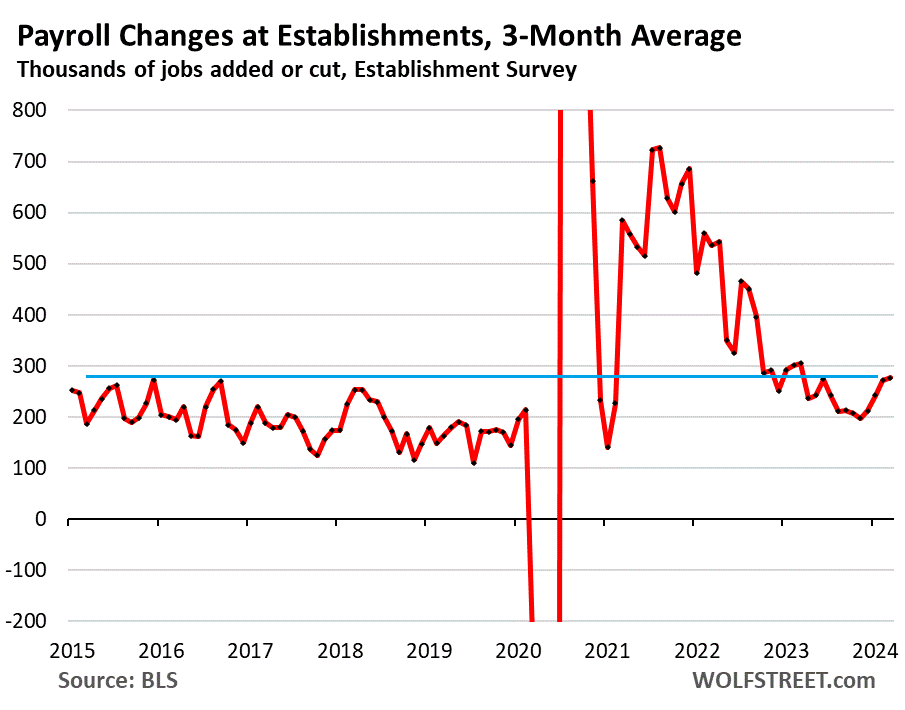
Folks can quibble with some of the details, but overall, it was fine – it has been fine every month for well over a year, exactly what you’d expect from an economy that’s plugging right along at a pace that is faster than we’ve come accustomed to over the past 15 years.
There is nothing in this jobs report – and we’ll get into the details in a moment – that indicates that the Fed should cut rates. The job market remains tight, wages are increasing at a good clip, and employment is growing at such a pace that inflation pressures emanate from it.
For the past 12 months, despite the interest rates that the Fed jacked up to 5.25%, nearly 3 million nonfarm payroll jobs have been added. Over the past three months, the pace accelerated to 3.3 million jobs a year annualized. The total number of payroll jobs rose to a record 158.1 million:
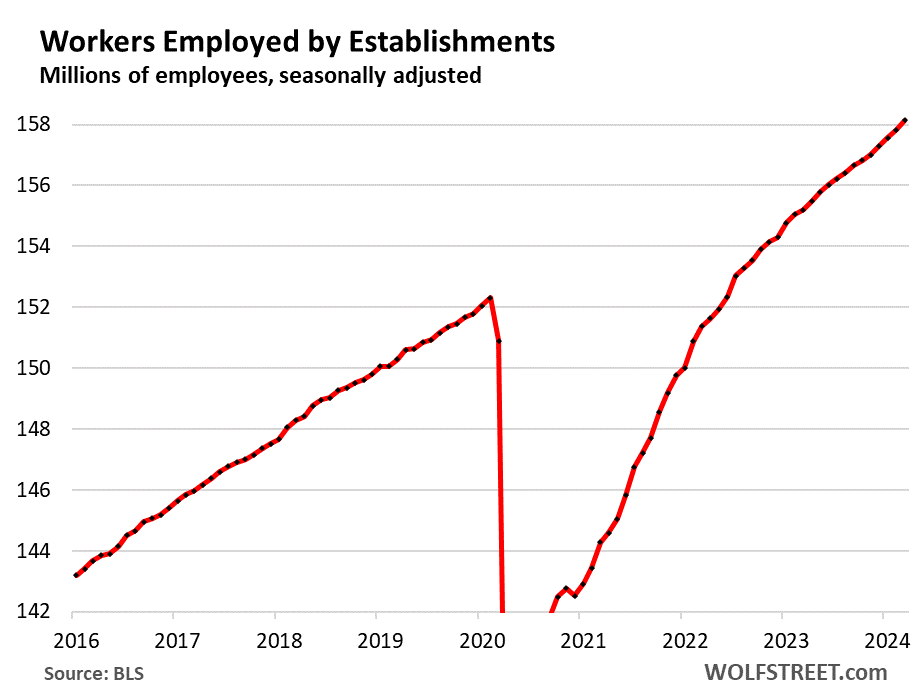
Average hourly earnings rose in March at an annualized rate of 4.3%, also according to the survey of employers, to $34.69. Over the past three months – which irons out the month-to-month squiggles – average hourly earnings rose by 4.1% annualized:
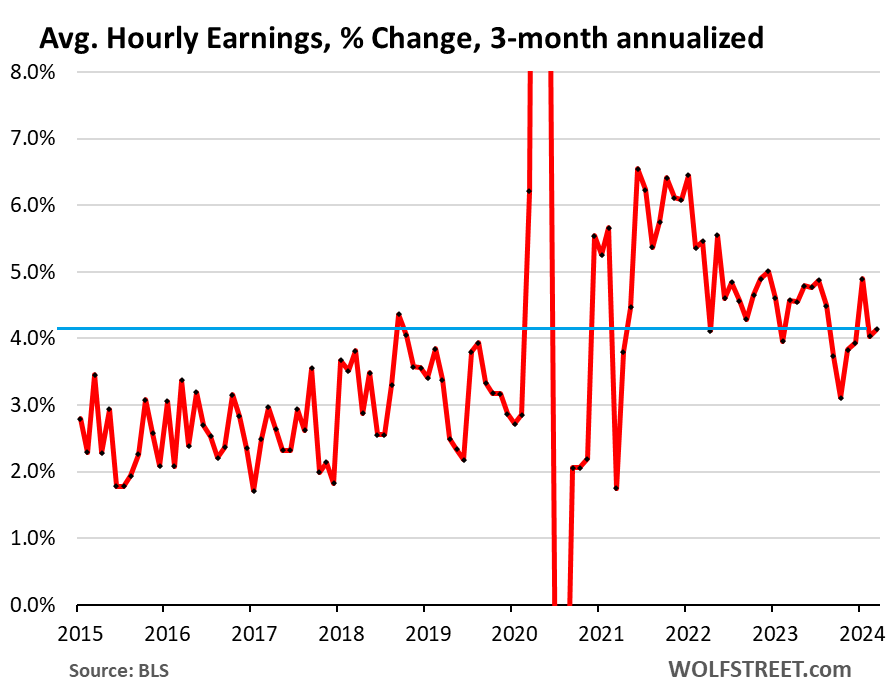
Household data of the jobs report messed up by underestimated immigration.
The remaining parts of the jobs report are based on the BLS survey of households. The BLS applies the survey data to the overall population count in the US to come up with its figures of employment, unemployment, the labor force, labor force participation, unemployment rates, etc. The BLS uses the population data from the Census Bureau. But the Census Bureau’s formula has massively underestimated the recent historic surge in immigration.
The Congressional Budget Office, however, has picked up on the massive surge of immigration, and its population growth data for 2022 and 2023 have shot far above the Census Bureau data. We discussed this the other day in detail and how it messes with the BLS household employment data. These are the two diverging population growth estimates:
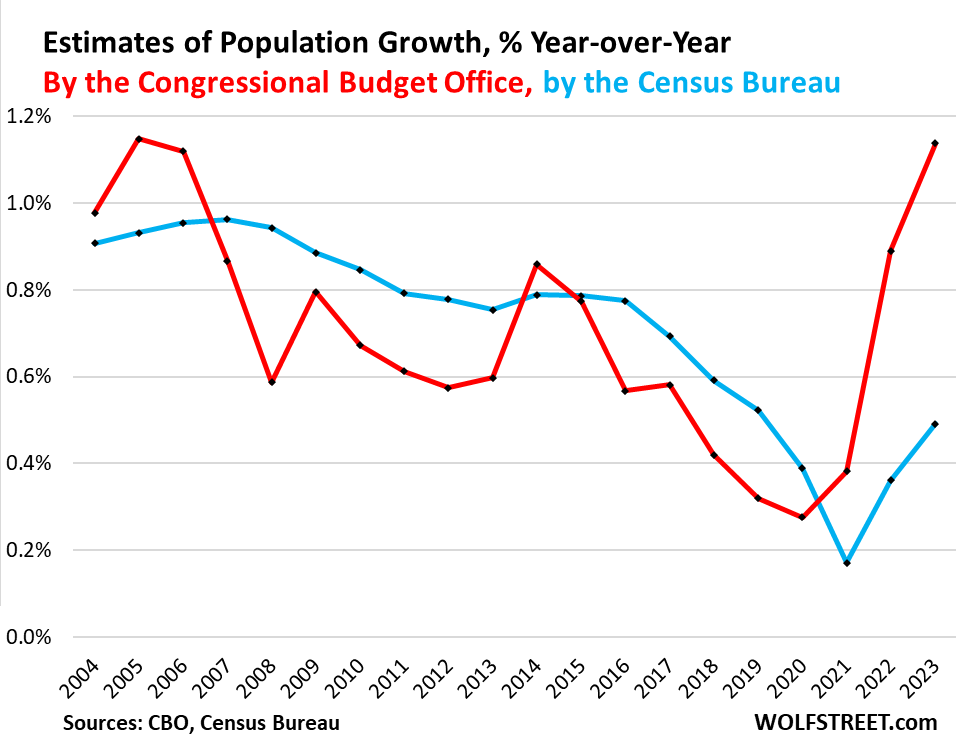
As a result of applying the survey data to the underestimated population count from the Census Bureau, the BLS understates total employment and the labor force which messes with all the other data. So it’s in this light that we need to look at the stuff below.
Nevertheless, here we sally forth into the Household survey data.
Growth in overall employment, which includes farm workers and the self-employed, per the survey of households and applied to the Census Bureau’s underestimated population count, rose by 498,000 after three months in a row of declines, to 161.5 million.
Given that this metric includes farm workers and the self-employed (and the payrolls data from employers does not), there is always a big difference between the total number of workers per household survey (red) and the workers on employers’ payrolls (blue). But that difference has dropped by half, due to the underestimation of immigration in the Census Bureau population data:
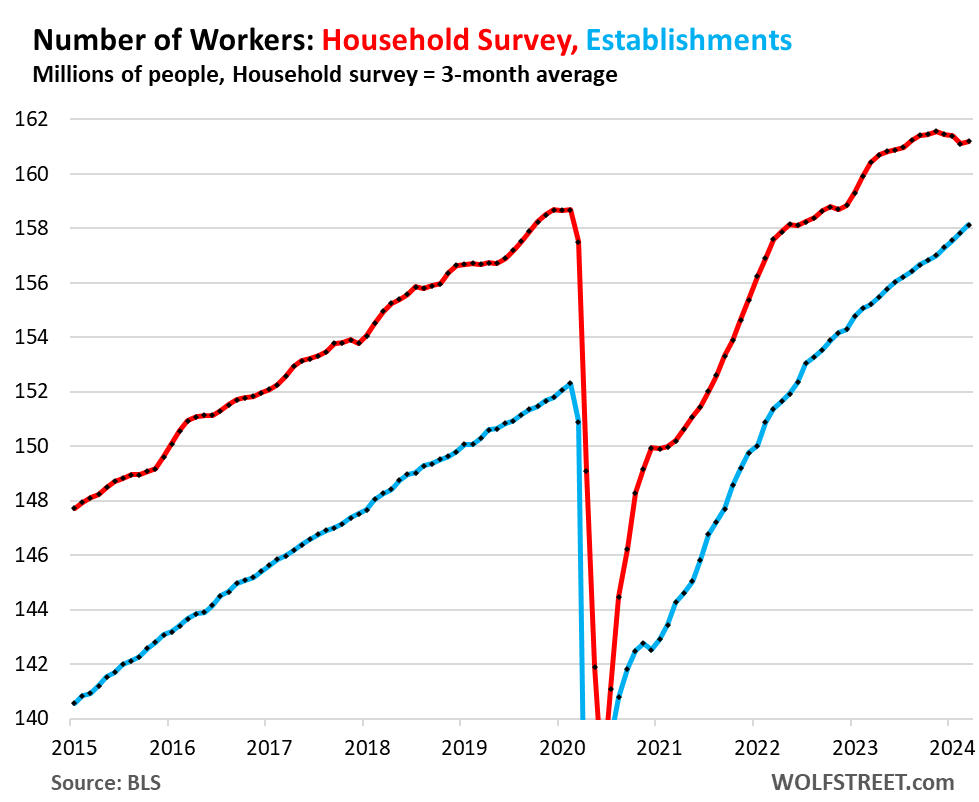
The labor force – also understated by the underestimated population count – rose by 469,000 in March to 167.9 million. The labor force consists of people who are working and those who are not working but actively looking for work.
The fact that the labor force has been dropping in recent months, despite the huge influx of immigrants who are looking for work or are already working demonstrates the impact on the data of the Census Bureau’s undercount of immigration:
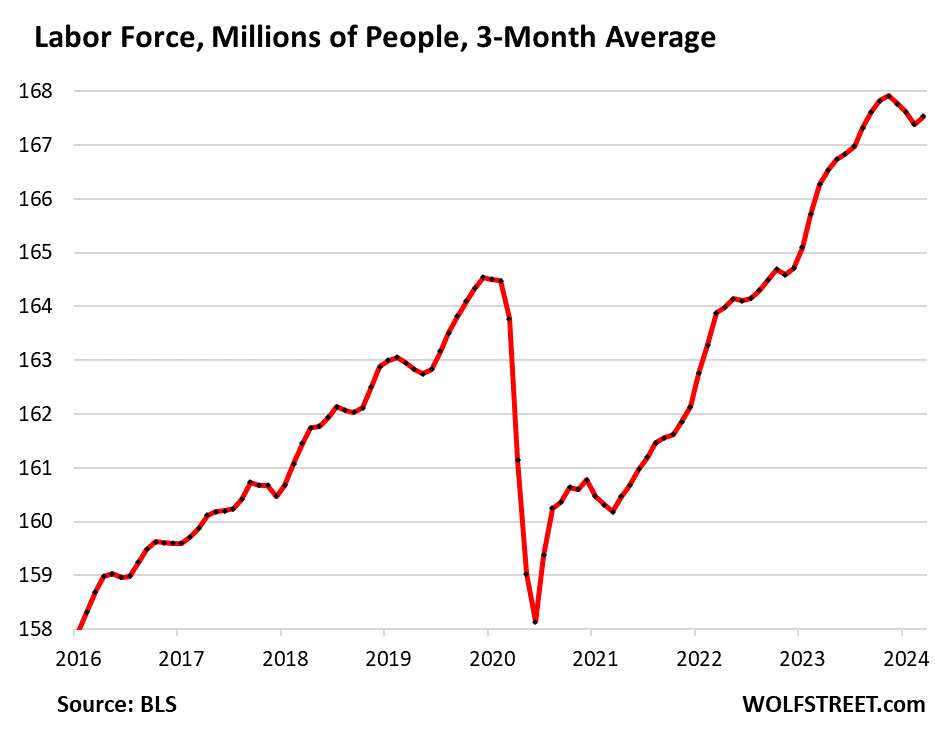
The prime-age labor participation rate – people between 24 and 54 – has remained in the same two-decade-high range, at 83.4%:
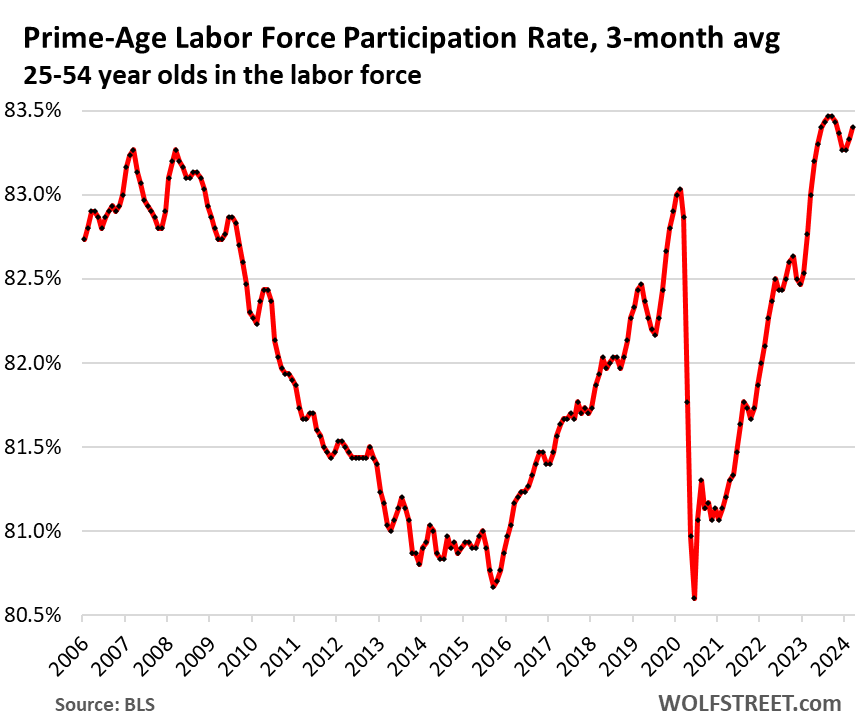
The number of unemployed fell by 29,000 in March, after a big increase in the prior month (blue). The three-month moving average, which irons out those month-to-month squiggles, ticked up for the second month in a row, after three months of declines (red).
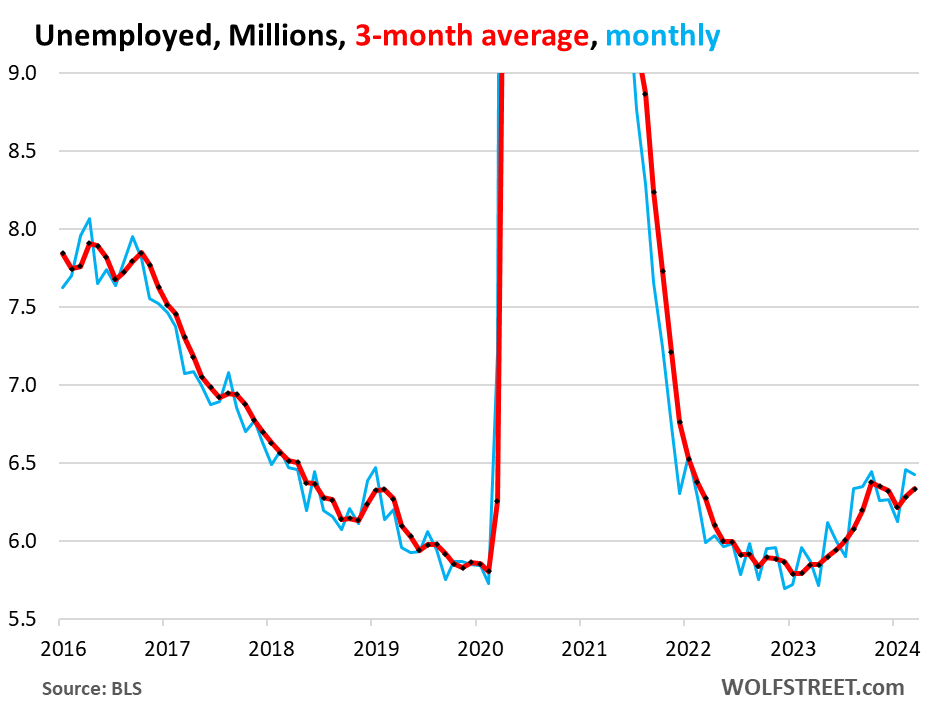
The unemployment rates – the BLS offers six unemployment rates – ranged from 1.3% for U-1, the narrowest definition, to 7.3%, the broadest definition.
U-3 is the official unemployment rate cited in the headlines (red in the chart below):
- 1.3% for U-1: persons unemployed 15 weeks or longer, % of civilian labor force
- 1.8% for U-2: job losers and persons who completed temporary jobs, % of civilian labor force
- 3.8% for U-3: total unemployed, % of civilian labor force (official unemployment rate)
- 4.0% for U-4, total unemployed plus discouraged workers, % of civilian labor force plus discouraged workers
- 4.7% for U-5: total unemployed, plus discouraged workers, plus all other marginally attached workers, % of civilian labor force plus all marginally attached workers
- 7.3% U-6: total unemployed, plus all marginally attached workers, plus total employed part time for economic reasons, % of civilian labor force plus all marginally attached workers.
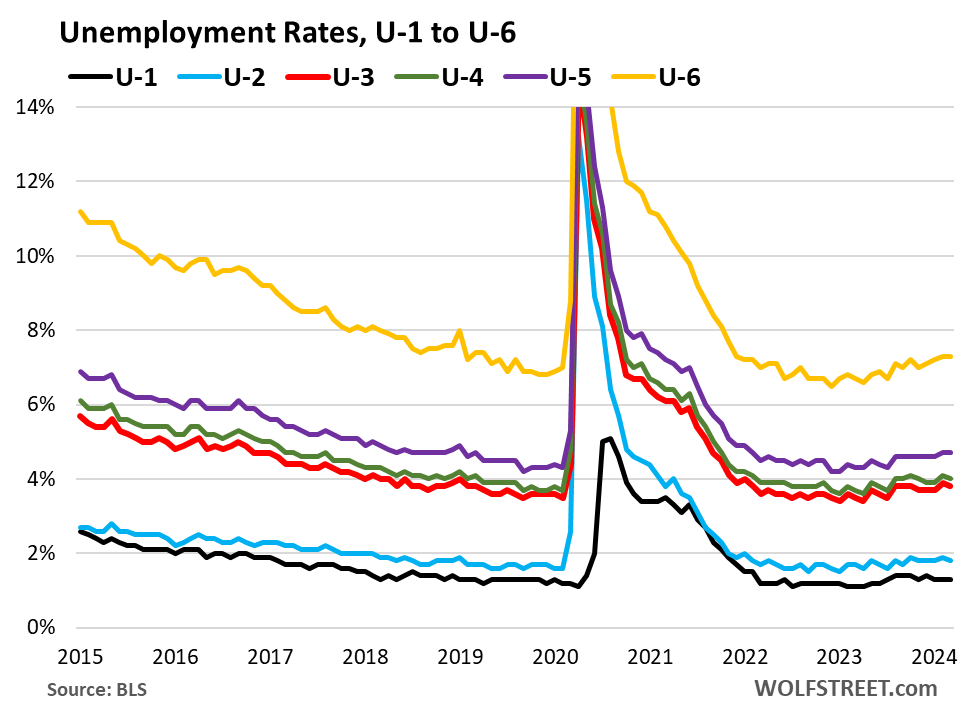
Part-time workers as percent of total workers had hit historic lows during the labor shortages in 2021 and 2022 but have since then risen, and remain very low historically, at 17.4% (three-month average):
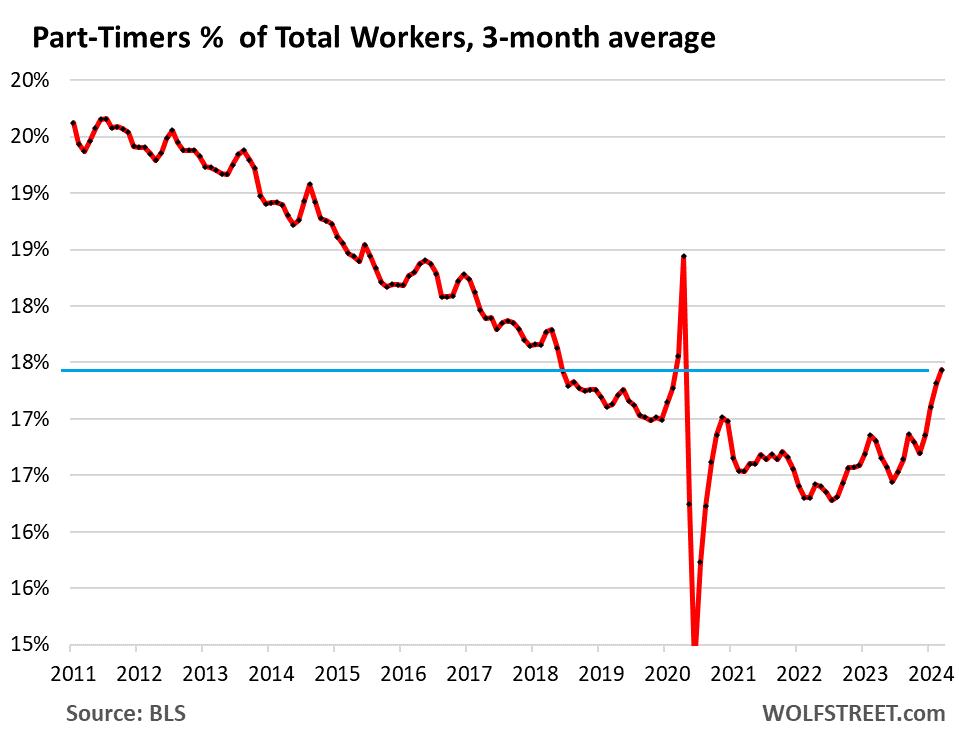
Self-employed workers as percent of total workers have remained in the normal range, having come up from the historic low during the labor shortages:
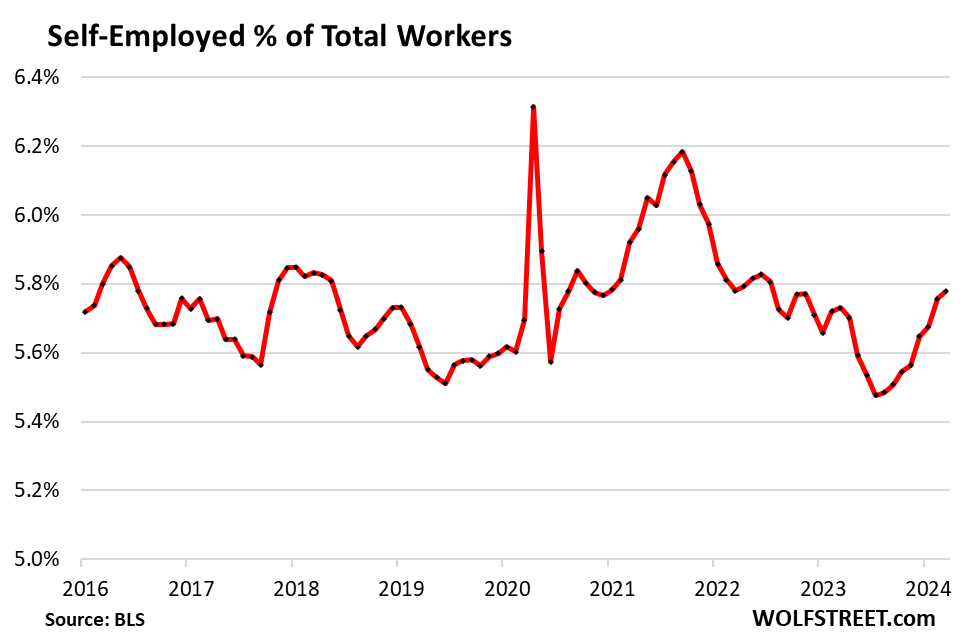
Multiple job holders as percent of total workers have dipped in recent months and remain in the normal range over the past 20 years, but are much lower than in the 1990s and early 2000s:
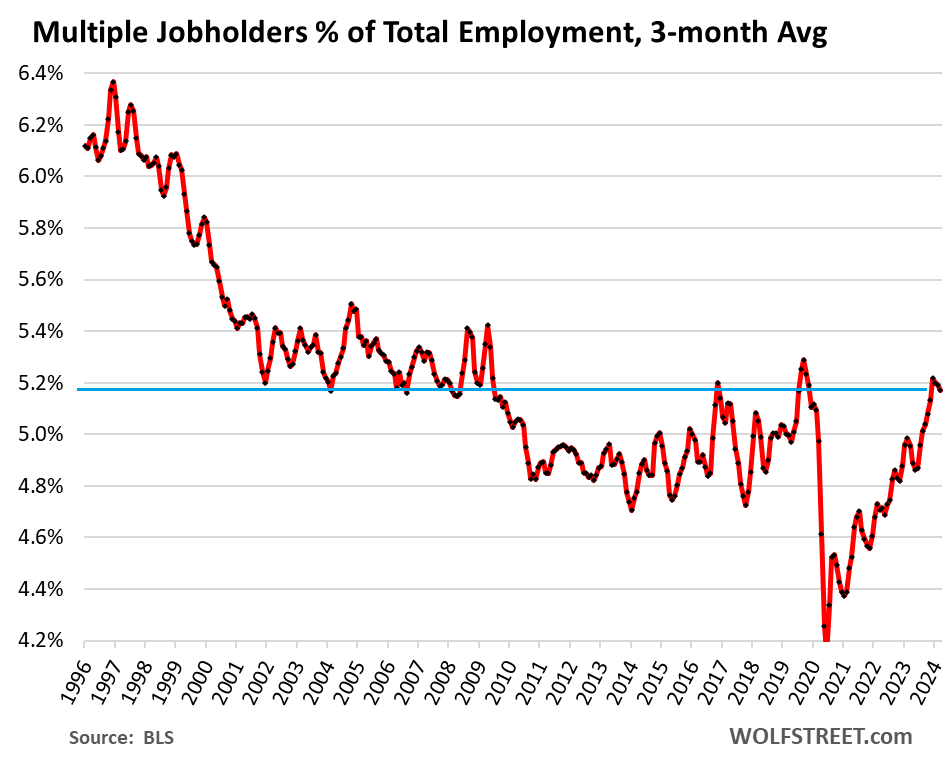
Enjoy reading WOLF STREET and want to support it? You can donate. I appreciate it immensely. Click on the mug to find out how:
![]()


Wolf,
Very well done write up. Extremely impressive.
Correct me if I am wrong, but the “rate cut fever” financial media pitch appears to completely misunderstand the employment situation.
Essentially, layoffs (which are happening in quite a few locations) are being absorbed by workers being hired elsewhere. People may be moving out of state for new jobs (so they show up as having gotten fired), but then a month or two later get hired in a new state.
The big issue being missed is that immigrants are getting hired in record number, possibly illegally, but still getting hired and therefore receiving pay and spending it.
Since there is a lot of layoffs, but then new hiring, possibly in other states, often with a lag, the bozos that are pushing the “economy is falling off a cliff, please please please bring back ZIRP” narrative just push data points out of context. Workers getting fired but finding a new job in a couple of months is simply consistent with the economy shifting, not slowing down (in fact, it is normal and healthy).
To apply a technical view to this, TLT (long term treasury ETF) is down 47% from its 2020 highs (actually it is worse than that if you count the COVID spike).
Speaking of firings, when do you think the ZIRP monger financial media, consultants, economists, etc. can get fired?
When you are wrong for 4 years, you would hope there would be repercussions and that would be a good place for headcount reductions.
There sure have been a lot of announcements of layoffs, but not necessarily layoffs.
There’s been a steady-stream bleeding out of IT jobs in New England for the past 21 months or so. And it’s got a heckuva lot more to do with offshoring than AI.
I wonder, does the establishment survey count employees that aren’t located in the US? Like, for example, a programmer located in India?
Tom S.
No, only US-based employees.
So, IT professional here, who has his ear to the ground in the industry. Here are the big trends I’m seeing amongst my colleagues in IT Services (non App Dev). YMMV, so here goes:
1. Offshoring has slowed down significantly, and where it continues, it seems to have shifted heavily away from India and toward Philippines, South Africa, Argentina.
2. Lots of new tools leveraging AI, automation and self-service are starting to eliminate entry level IT positions (think simple things like password resets, user account creation/termination, answering basic end-user questions such as ‘how do I setup my VPN?’)
3. Friends who run appdev teams are really trying to leverage AI in lieu of offshoring because the time, language, and cultural barriers are real, and a significant source of friction that still have yet to be overcome.
Anecdotal case study: we’ve just implemented two new automation tools that do a good job of leveraging AI to help us streamline our operations and service delivery. New user account creation has gone from a 30-45 minute process to 5 minutes of Q/A review (and far fewer mistakes, to boot). PC setup has gone from 3-4 hours from unbox to swap down to 45-60 minutes.
The net result for us is that we had anticipated hiring 10 people this year. At this point I think we’ll hire 3, at most, barring bringing on some significant new business which dictates it.
We’re actively working with our existing staff to upskill them as fast as they are willing and able to learn, because the problems we’ll need them to solve will require more brainification and less checklisting.
How is AI used to add a new user account or set up a machine? Seems like a few scripts in the first case and an image with a few more scripts for the second. What role do the neural networks and deep learning come in? And can you name these products? I hear a lot about AI and I’ve built and published neural networks to do image analysis decades ago but I’m curious how that stuff is being applied today
I have personally seen a good number of layoffs. The people who got laid off all got new jobs within a few months.
Do you think it is funny that the media reports on the layoffs, but not on the fact that everyone got new jobs?
I guess “27 Local Companies Initiate Layoffs– But all the workers expect to get new jobs within a few months” doesn’t sell as a headline.
Bond Vigilante Wannabe,
Most companies are not anywhere near the size of Google, Meta, or Microsoft. They let people go by the handful, not by the hundreds.
There is *absolutely* a secular-looking loss of jobs going on in the IT sector right now.
There is a continuing loss of jobs going on in manufacturing.
Replying to BigAI about his comment: There is *absolutely* a secular-looking loss of jobs going on in the IT sector right now.
I can firmly corroborate this. Job loss because of offshoring not AI.
Bond Vigilante Wannabe,
Remember the old axiom in the media business – if it bleeds, it leads. “Bleeding” headlines generate more clicks and attention so the fact that most laid off workers are quickly finding other positions will go unmentioned – at least in the headline.
The US media also tends to portray employers as ruthless and uncaring. Layoffs are a good example – ever notice how frequently the word “slash” is used in such headlines?
“GE slashed their payroll by 500 positions.” It has a nice ring of violence and bloodshed. The savage beast of an employer.
Not everyone gets a new job. If you are >50 and laid off in high tech, odds are high your career is over.
Short TLT continues to be a good trade.
Yup! Those pivot mongers keep getting uppercuts and cross hooks to the face, and keep saying “thank you sir, may I have another!”
Looks like you guys on recession watch should go refill your coffee cups, you still have a long time to wait.
Maybe so but maybe not. Nobody has a crystal ball. It took me 3 months with a spotless record, all my CDL endorsements including hazmat and TWIC and years of experience to land another trucking job after I quit my last one.
And the only reason I got this one is because it’s delivering construction machinery and then operating it when I get to the job site.
I know of 3 other drivers who run for the big mega carrier OTR companies who took a 5-10% per mile pay cut on top of a severe cut back in miles within the past 6 months. Equalling a 20-30% realized pay cut. One guy went from .58 cents per mile to .49 cents per mile or he’d be terminated. He ran generic flatbed loads.
Maybe trucking is in a unique spot (it kind of is) but usually it’s like construction, it’s the first to get the boot when the economy goes down the tubes.
Sure, I do agree there’s absolutely no reason for them to cut rates. In fact IMHO I think they can ratchet it higher to bring inflation down to target sooner and make sure it stay there.
I am just not so confident Pow Pow will do the tough thing not to not tank the market, takes a lot of backbone to not budge if the market start tanking like a rock knowing the glue they are sniffing will be gone soon instead of coming in Q3 or Q4
“I think they can ratchet it higher to bring inflation down to target sooner and make sure it stay there.”
Indeed they can, and they should. But they won’t.
Depending on what happens with inflation they might have to 👀 oil
If they had to raise again that’d be fun 🍿
Well said. And the “market tanking like a rock” will only last a few days at most, not weeks or months, before they feel the “pain.” It’s the most they can bear.
Do you know why there is a phrase “Never Fight the Fed”… because so many investors are inclined to do so!
It is not Powell’s job to save the stock market (or its investors). Starting in early 2022 he raised interest rates 4.5% in fifteen months while the DJIA dropped 21% in that same time frame. He didn’t give a flip about stock prices then and he doesn’t give one now. Stock market investors have now bet big that the Fed will cut its rates… but if investors want to lose their shirts running this market up while Powell and Company are warning them not to… it is on them not him.
Since the start of the tightening cycle, the Fed has done exactly what it said it would do, every step of the way.
I agree with you. Particularly with THIS tightening cycle.
They have been wanting to tighten ever since 2015. But to be honest, they have been saddled with both Republican and Democratic governments that have little interest in running the Fiscal side properly while the FED regains control of its Balance Sheet on the monetary side. They spent eight years trying to recover from GFC mess… which was their responsibility… no problem there. And they had to respond to the COVID pandemic… okay. Both times they went too far for too long but that is hardly unusual… it even has a name… “policy drift.”
In the middle they got to try QT1… which worked for a while but they coupled it with unnecessary interest rate hikes and eventually the markets froze. NOW they are tightening again and for two years have been steady as a rock in doing so… and nobody wants to believe them even as they are TWO YEARS into it at this point.
As the OTHER saying goes… F*&k Around and Find Out. These money managers who have never seen a prolonged bear market want to keep fighting the Fed by bidding stock prices (and other asset prices) up. It won’t end well for them.
Rates are high only in the mind of the ZIRP addicted. The Chicago Fed National Financial Conditions Index shows these rates are all bark and no bite.
Andrew,
We have the worst of all worlds right now.
The rate increases haven’t slowed financial speculation even a little bit, but have made it more costly to invest in the “real economy” (i.e. to boost supply).
Agree. Nothing in the jobs report indicates a rate cut is coming.
As was said a number of times before. Thank God for the Fed. They have done an extraordinary job in the face of the pandemic, the irresponsible congress and the more irresponsible titans of wall street.
Folks, it really doesn’t get any better than this.
Start the Friday night hallucinogens early?
Is it ever too early on Friday for say a shroom?
Asking for a friend.
You’ve fallen from your rocker Louie.
God and fed in the same sentence?
I say man has ruled this world as a stumbling demented child king long enough, and as his empire crumbles my precious black widow shall rise as his most fitting successor – Vincent price.
Think you forgot /S to your post? If not, then thanking the FED for doing a great job is about as much as thanking a an arsonist who happens to moonlight as a firefighter…
Let’s see which FED unleashed the biggest liquidity flood in recent human history in a matter of couple of months and lowered interest rates to next to zero so now every crack house in SoCal in semi-decent neighborhood is asking for $1M minimum as price of entry..yeah thank you Pow Pow, job well done..
since when is 4 or 5% not normal. I do not believe 3% or 4% Fed funds would be normal or historical. Leave rates where they are would be just fine.
10 year yield back to 4.4% 🤩
After 15 years of artificially repressed rates, it feels good to be able to hold at least some amount of cash & earn a nontrivial yield on it.
It sure does!
So now we have increasing inflation, high borrowing costs, and still rampant speculation in the real estate market because they are expecting rate cuts.
What a great job the fed has done.
The FED has egg all over their faces yet again. Just a miserably derelict bunch of hacks, hoping and praying that inflation would magically go away without any sort of backbone to actually get aggressive and make sure of it, instead talking of rate cuts and such.
They couldn’t even be bothered to raise the last 25 basis points when they did the big pause to juice the markets. Both political parties are bought and paid for by the billionaire speculators, and we have the Roaring 20s on steroids.
There was a class war. It is over. The wealthy won.
The war doesn’t have to be over but certainly the battle was lost. There was a time in the US ( and much of the world) when the workers tried to right the ship. Right now however the material conditions don’t exist for it here as things aren’t so bad as to really get any real momentum. Plus, trade unions tend to look out for their own interests rather than seeing themselves as just intersectionality with the core class issue.
I look forward to wearing my Che revolution shirt to jury duty. Thinking that will get me a hall pass!
The Fed is in full on politically neutral until after the election of either one of the older gentlemen being offered up.
Higher pay and a robust job market is actually what is needed by the ignored median of the population. The concentration of wealth has predictably, weekend the democratic resolve of the society.
I remember when it began with ” shock and awe” , an epic error. Oopsie
For the last 20 years or so the Fed funded the relocation costs of American manufacturing to the Chinese communist work force.
When you add all the people working “Off the books” the job market is even better than reported. If anything the Fed should send a clear message to the Wall Street chills and speculators and raise interest rates at the June meeting.
No, what really should happen is for Congress to impose by statute a requirement that the Fed Funds rate may NEVER EVER be below 4%, no matter how bad the economy.
But they’re cowards, so they won’t.
They’re not cowards in Congress. They’re free-money addicts.
Congress has a degree of integrity that impedes the greed impulse. Citizens United declaration opened the floodgates for purchasing a the 536 strong public employees willing to sell their duty for a pittance.
I look forward to the cardboard future that AI, incapable of an original thought, has crafted.
Easy money is probably the most addictive substance in existence. Just above bread.
There is a substitute “requirement”. It’s the 16th amendment that authorizes income tax, but not asset taxes. When the Fed manipulated interest rates, that resulted in “real” interest rates being negative, that constituted a tax on assets, such as bank deposits. During the 2% inflation era, the Fed’s discount window was at 0.25%, effectively capping interest on deposits at 0.25% or less.
Meanwhile, loans were subsidized, resulting in it making sense for corporations to borrow to buy back stock. Different classes were benefiting from the subsidized borrowing as opposed to the asset tax, so it’s part of class warfare favoring the rich.
Thanks for your fair non-biased reporting on economics Wolf.
It’s amazing how many of the familar bearish analysts out there have been saying for 15 straight years now that every single NFP report is garbage, the labor market really sucks, the economy is fake, etc…. I have literally watched some of them pick apart every single last NFP for 15 yrs! Not kidding you, every last one since the end of the GFC in March 2009. And they are still at it. You have to be careful who you listen to.
Oil is skyrocketing and it is a tailwind for inflation, bond yields also rising , do not surprise if we see a 10Y yield at 5% in few months, I don’t see the FED’s 2% inflation target in this scenario , rather they should start thinking about moving those rates up again, was to early for that pause, so, look where we are.
Right, it’s not just oil. A bunch of commodities from gold to copper to cocoa beans 🫘 also bubbling up in recent weeks. The Dow Jones Commodity Index is up 7% YTD.
Well, inflation is stable at somewhere between 4 and 7% as the general price level increases the value of assets increases, inflation, the worst disease that an democratic American elected government can inflict on it’s citizens, is injustice. Alternatively, the best is a just system that does not discriminate so blatently,
how can the rate go down when there is so much illegal immigration? due to rule changes, one can cross illegally then apply for asylum. Post application, you can work legally :) The asylum applications take forever to review. It’s really not that surprising.
Powell is doing an extraordinary job tightening money. Short-term flows are still up till June, but long-term flows are going to turn negative in the last half of the year.
Isolating money intended for spending, from the money held as savings is what the FRB-STL’s article comments on:
“Recent developments in bank deposits”
The distinctions are important because only money that is spent-so-called “true money” – influences prices and inflation.
fincl conditions are looser now than before the first rate hike,,,
Powell is doing an extraordinary job tightening money.
Is that the first line of a joke about the obvious excess liquidity that is propping up several asset bubbles. Or an opinion that the Fed has suddenly embraced religion as the reason they do what they do.
I’m not quite full “Depth Charge,” but I agree that the Fed whimped out on the last 25 bps hike.
The “proven” solution to inflation is positive real rates. Even J. Pow was saying this, early on.
I feel it’s more difficult to measure how positive or how real the rates are anymore, due to the strange, distorted feeling modern economy.
There’s shadow banking systems and public offerings and so many pathways to acquire funding (then turn around and monetize/ pass off the burden) it’s no longer just the Fed overnight rate.
Looking at the long end and baking in entrenched inflation expectations is not looking like an appealing desert for a middle aged wage earner.
Guess I should have bought more assets at ATHs? I guess there’s still time for that!
Maybe it is a rolling recession as they say.
IT jobs are few and far between. Recent graduates of computer science major cannot find jobs. This is based on first hand knowledge of many students of mine experiencing difficulty in finding jobs. The situation is complete opposite just a couple years ago. My former students are telling me that their companies are not hiring at all, which is usual.
Maybe ChatGPT is removing many programming positions already. Office workers are next?
Offshoresville.
I think I saw three articles circulating yesterday citing layoffs at large companies….
Gotta start the layoff propaganda again to scare the job jumpers
Ouch on TLT today.
Next week should be fun 🎢
Wolf, would it be fair to suggest that the real interest rate i.e nominal interest rate minus inflation is too low to have any effect on reining in inflation?
If the truth be known, the way inflation is now calculated, the real inflation rate is above the nominal rate set by the Fed. Therefore any suggestion of lowering rates should be out of the question.
Your way off, percentage of government jobs is over close to 50% if not over, the create nothing do not contribute anything to GDP. Liesure and hospitality are low paying jobs. Manufacturing jobs zero. Waiting for that investments in America act to kick in like Obamas shovel ready jobs that didn’t exist. Some good news, The Secretary of Transportation has a hybrid electric car. Looks like Pete still needs fossil fuels.
Such BS. On all counts. So here is just about your first line of BS, government jobs 🤣:
And here are manufacturing jobs, for your entertainment:
And while we’re at it, construction jobs — and construction companies would have added more jobs, but they have a lot of trouble filling their job openings, which are at record high:
Buffet stated his solution:
Whenever the government deficit exceeds 3% of GDP all congressional members are not eligible for reelection.
Done
Better would be some multiplier, such as 1% deficit = 3% ineligible for re-election, 3% = 9% ineligible.
Boy this sure is interesting to watch. It does feel like money is moving and that is keeping the economy humming along. Yet the threshold for middle class living standards are getting too far out of reach for lots of the population. It’s all very confusing. Like since FASB dropped mark to market in 2008 the whole trip is just a brilliant confidence game. Now we have serious international violence occurring in two complex and important regions of the world, to the benefit of who, or what, exactly? The information ecosystem of the electronic mass media is both panopticon and propaganda. The political culture is caricature and cosplay. What’s the agenda? Is there a plan? Where we going? Thanks Wolf for not manipulating the analysis.
“Boy this sure is interesting to watch. It does feel like money is moving and that is keeping the economy humming along. Yet the threshold for middle class living standards are getting too far out of reach for lots of the population.“
The two are not mutually exclusive. Inflation causes both to happen at the same time.
Everyone has jobs due to government spending, but downwind the prices of everything are rising faster than people’s wages.
The Fortune 500 company that I work for just did a 3% across-the-board pay raise. The problem is that this a casino corporation… where EVERY employee understands money. A 3% pay raise in a 3.9% core inflation rate economy isn’t going to win management many fans.
and management cares because…?
what are you all going to do.. like, b*tch for a minute in the break room or on social media? hahah
then you’ll just go back to your assignment/station/desk/whatever. and that will be that.
the PROBLEM isnt the corporation. its you silly ‘smart about money’ wussies that work for it…
Chuckle… yeah right.
Because they remain open 24/7, it may not be apparent to customers and other outsiders, but casinos are surprisingly easy businesses to run into the ground. Unlike a Walmart that attracts customers due to its low prices and can thus survive unhappy employees (since the customers have little interaction with them)… casino customers CONSTANTLY deal with employees (and for extended periods of time). There are few differences in the actual games (slots/table/poker/sports betting) that different casinos offer… so the make-and-break difference boils down more to customer satisfaction on the “softer’ side of the experience.
Thus a casino where displeased employees are looking to jump to another casino (or to … shudder… UNIONIZE!) is a casino in trouble. Like an airline where the planes are always flying (even in bankruptcy) there is a lot of management turnover in the background of a casino company that isn’t very visible to outsiders. But you better believe the insiders are paying attention.
…..but Spencer, if those employees take that pay raise and literally save it, no matter what the inflation rate, demand for goods and services are reduced which in theory and practice reduces inflation. Contrary to the last decade +, putting all your eggs into assets because they far out way the current inflation, maybe stop with the game of brinkmanship. Your only creating the problem you have now. Let the chips fall where they are, with your savings you have liquid gold for the next bull run in markets and assets.
But if they take that money and put it in something interest bearing (=loaning it out) the money supply increases, which is inflationary in the future.
It is a bull market in (i) part-time jobs, (ii) self-employment and (iii) multiple job holders. Outside of these areas, employment actually contracted more than -500k in March and by -2 million in the past year. What an economy!!
(from David Rosenberg via twitter )
Stupid bullshit. RTGDFA where we show you these three charts, directly from the article 🤣
Part-time workers as percent of total workers had hit historic lows during the labor shortages in 2021 and 2022 but have since then risen, and remain very low historically, at 17.4% (three-month average):

Self-employed workers as percent of total workers have remained in the normal range, having come up from the historic low during the labor shortages:
Multiple job holders as percent of total workers have dipped in recent months and remain in the normal range over the past 20 years, but are much lower than in the 1990s and early 2000s:
Tech industry brought India to US via H1B.
I remember Microsoft sending managers to India to ‘manage teams’ there (~1990’s?). Remeber englash taught via cowboy talk ;). Didn’t work out for Microsoft. So the Puget Sound lore goes. Microsoft began to bring the people to US. If I recall, at one time (2000’s) east Bellevue / Factoria was the most diverse (incoming culture) in the US. Then, somewhere ~2013 the area around Southern Snohomish County (just south easterly of Mill Creek Wa) was the fastest growing area of US. Lot’s of India inhabitants. Take a look at the census or next census. India is here in US. Don’t need to offshore so much anymore. IMHO
That prime-age labor participation rate is interesting. I wonder why it dropped as much during the Obama years as it did for COVID. Were people paid to not work then also?
Nah. In 2009, when Obama started, boomers were starting to be older than 54 in very large numbers, which is the upper limit of “prime age” (25-54), though they were still working. The first boomers turned 54 in about 2000, and by 2010, half of that huge generation had turned 54 and had been moved out of the “prime age,” though they were still working. By 2019, ALL boomers were over 54 and had been moved out of “prime age.” That’s why you see that decline in “prime age” participation rates.
But in about 2016, the Millennials, the largest generation ever, had started to move into “prime age” in ever larger numbers, and were working in ever larger numbers, and that’s why “prime age” rose from that point on.